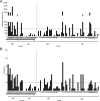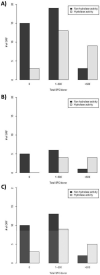Immunoproteomic analysis of house dust mite antigens reveals distinct classes of dominant T cell antigens according to function and serological reactivity
- PMID: 27684489
- PMCID: PMC5374056
- DOI: 10.1111/cea.12829
Immunoproteomic analysis of house dust mite antigens reveals distinct classes of dominant T cell antigens according to function and serological reactivity
Abstract
Background: House dust mite (HDM) allergens are a common cause of allergy and allergic asthma. A comprehensive analysis of proteins targeted by T cells, which are implicated in the development and regulation of allergic disease independent of their antibody reactivity, is still lacking.
Objective: To comprehensively analyse the HDM-derived protein targets of T cell responses in HDM-allergic individuals, and investigate their correlation with IgE/IgG responses and protein function.
Methods: Proteomic analysis (liquid chromatography-tandem mass spectrometry) of HDM extracts identified 90 distinct protein clusters, corresponding to 29 known allergens and 61 novel proteins. Peripheral blood mononuclear cells (PBMC) from 20 HDM-allergic individuals were stimulated with HDM extracts and assayed with a set of ~2500 peptides derived from these 90 protein clusters and predicted to bind the most common HLA class II types. 2D immunoblots were made in parallel to elucidate IgE and IgG reactivity, and putative function analyses were performed in silico according to Gene Ontology annotations.
Results: Analysis of T cell reactivity revealed a large number of T cell epitopes. Overall response magnitude and frequency was comparable for known and novel proteins, with 15 antigens (nine of which were novel) dominating the total T cell response. Most of the known allergens that were dominant at the T cell level were also IgE reactive, as expected, while few novel dominant T cell antigens were IgE reactive. Among known allergens, hydrolase activity and detectable IgE/IgG reactivity are strongly correlated, while no protein function correlates with immunogenicity of novel proteins. A total of 106 epitopes accounted for half of the total T cell response, underlining the heterogeneity of T cell responses to HDM allergens.
Conclusions and clinical relevance: Herein, we define the T cell targets for both known allergens and novel proteins, which may inform future diagnostics and immunotherapeutics for allergy to HDM.
Keywords: T cell epitopes; allergens; house dust mite; proteomics.
© 2016 John Wiley & Sons Ltd.
Figures


Similar articles
-
A hypoallergenic peptide mix containing T cell epitopes of the clinically relevant house dust mite allergens.Allergy. 2019 Dec;74(12):2461-2478. doi: 10.1111/all.13956. Epub 2019 Oct 3. Allergy. 2019. PMID: 31228873 Free PMC article.
-
Definition of a pool of epitopes that recapitulates the T cell reactivity against major house dust mite allergens.Clin Exp Allergy. 2015 Oct;45(10):1601-12. doi: 10.1111/cea.12507. Clin Exp Allergy. 2015. PMID: 25652035 Free PMC article.
-
Sequence conservation predicts T cell reactivity against ragweed allergens.Clin Exp Allergy. 2016 Sep;46(9):1194-205. doi: 10.1111/cea.12772. Epub 2016 Jul 26. Clin Exp Allergy. 2016. PMID: 27359111 Free PMC article.
-
House dust mite allergy: from T-cell epitopes to immunotherapy.Eur J Clin Invest. 1993 Dec;23(12):763-72. doi: 10.1111/j.1365-2362.1993.tb00729.x. Eur J Clin Invest. 1993. PMID: 7511533 Review.
-
Hierarchy and molecular properties of house dust mite allergens.Allergol Int. 2015 Oct;64(4):304-11. doi: 10.1016/j.alit.2015.05.004. Epub 2015 Jun 13. Allergol Int. 2015. PMID: 26433526 Review.
Cited by
-
Allergen and Epitope Targets of Mouse-Specific T Cell Responses in Allergy and Asthma.Front Immunol. 2018 Feb 13;9:235. doi: 10.3389/fimmu.2018.00235. eCollection 2018. Front Immunol. 2018. PMID: 29487600 Free PMC article.
-
Epitope prediction and identification- adaptive T cell responses in humans.Semin Immunol. 2020 Aug;50:101418. doi: 10.1016/j.smim.2020.101418. Epub 2020 Oct 31. Semin Immunol. 2020. PMID: 33131981 Free PMC article. Review.
-
Cockroach immunotherapy modulates dominant T-cell responses independent of allergen extract content.J Allergy Clin Immunol. 2025 Jul 24:S0091-6749(25)00798-5. doi: 10.1016/j.jaci.2025.07.011. Online ahead of print. J Allergy Clin Immunol. 2025. PMID: 40714043
-
Identification of cow milk epitopes to characterize and quantify disease-specific T cells in allergic children.J Allergy Clin Immunol. 2023 Nov;152(5):1196-1209. doi: 10.1016/j.jaci.2023.07.020. Epub 2023 Aug 19. J Allergy Clin Immunol. 2023. PMID: 37604312 Free PMC article.
-
The association of allergic sensitization patterns in early childhood with disease manifestations and immunological reactivity at 10 years of age.Clin Exp Allergy. 2019 Aug;49(8):1087-1094. doi: 10.1111/cea.13406. Epub 2019 May 29. Clin Exp Allergy. 2019. PMID: 31046157 Free PMC article. Clinical Trial.
References
-
- Soyer OU, Akdis M, Ring J, Behrendt H, Crameri R, Lauener R, Akdis CA. Mechanisms of peripheral tolerance to allergens. Allergy. 2013;68:161–70. - PubMed
-
- Pernas M, Sanchez-Ramos I, Sanchez-Monge R, Lombardero M, Arteaga C, Castanera P, Salcedo G. Der p 1 and Der f 1, the highly related and major allergens from house dust mites, are differentially affected by a plant cystatin. Clinical and experimental allergy : journal of the British Society for Allergy and Clinical Immunology. 2000;30:972–8. - PubMed
-
- Deb R, Shakib F, Reid K, Clark H. Major house dust mite allergens Dermatophagoides pteronyssinus 1 and Dermatophagoides farinae 1 degrade and inactivate lung surfactant proteins A and D. The Journal of biological chemistry. 2007;282:36808–19. - PubMed
-
- Machado DC, Horton D, Harrop R, Peachell PT, Helm BA. Potential allergens stimulate the release of mediators of the allergic response from cells of mast cell lineage in the absence of sensitization with antigen-specific IgE. European journal of immunology. 1996;26:2972–80. - PubMed
MeSH terms
Substances
Grants and funding
LinkOut - more resources
Full Text Sources
Other Literature Sources
Medical
Research Materials

